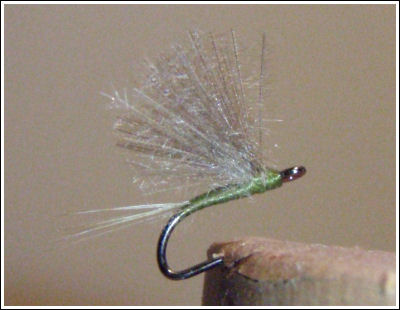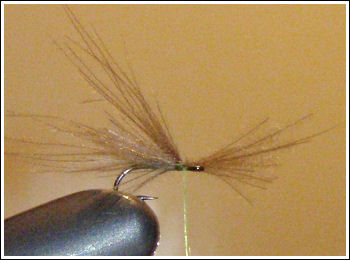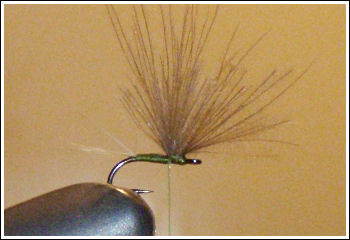|
Tiny BWO
By Goran Grubic

The
Blue Winged Olive (Serratella ignita) is probably the most
widespread mayfly species in Europe. There are literally
hundreds of flies tied to imitate this species. In the latter
years I realized that most of the times when that fly is
hatching both trout and grayling prefer to take emerging BWOs.
Various emerger patterns are quite successful, usually tied with
CDC wings. This time I would like to show the one that was the
most successful for me, which I call Tiny BWO, because it works
best when tied on small hooks.
I must explain that on
the Balkans, where I fish, there is not one but five recorded
species of BWO (members of Ephemerella family, which look almost
identical and live in the same rivers, with only small
differences in their size. It is well known that on most of the
European rivers BWO imitations are tied on hooks size 16
(ranging from 14 to 18), but on the Balkans it may go down to
the size 22 or 24. On the rivers where fish are not under much
fishing pressure the issue of size may not be so important, but
on the rivers where catch and release is the rule (and their
number is increasing) on most of the days it is very important
to have BWO size 20 or smaller. And they are hatching almost
every day during the summer and autumn.
Considering all of the
above, I constructed very simple little BWO emerger. It is a
variation of No-hackle patterns made famous by Swisher and
Richards. In the book titled “Emergers” published in 1991 they
recommended similar no-hackle flies with CDC wings. They called
them Duck Rump Patterns. Those flies were tied with dubbed
bodies, and this is how I tied them first. Latter, trying to get
as simple flies as possible, I abandoned dubbing and started to
tie them with the whole body made just of tying thread.
There are many fine fly
tiers on the Balkans and probably many of them tie similar
flies, so I don’t think that this pattern is very original. But
there is one detail that is special – it is the hook model which
is used. In many of the standard hooks designed for fly tying
wire used for sizes 20 and smaller is very fine. I had
situations where hooks made by several respected brands were
broken or open, sometimes at the hooking moment and sometimes
later during the fight. The mistake was certainly mine because I
tend to strike fast and strong, which is not surprising
considering that about 80% of the time I fish with heavy nymphs.
Knowing that after over 40 years of fly fishing I cannot change
my habits, I was looking for a hook
model which is strong enough in small sizes. And I discovered it
in the Mustad “Black Nickel Eyed Maggot Barbless Hook 90344BLN”
which they list under Long Point/UltraPoint Freshwater hooks in
their online catalogue (http://www.mustad.no/productcatalog/product.php?id=290)
. There is also a barbed version of that hook, but in small
sizes it is much better to use barbless variety. Not only
because it is easier to release fish from such hooks, but also
since it is much less harmful when such a hook finds its way to
my finger or shirt. Their wire is quite strong and there is also
a bonus feature – the eye is large compared to those in “proper
fly hooks”. They make them in sizes from 12 to 22 but their
actual size is smaller compared to standard fly hooks (like
Mustad 94840).
I was amazed when I
discovered those hooks in the “coarse fish” department, because
they are really perfect for fly tying but were completely
unknown as such. Maybe the “maggot” in the name makes them
unattractive for fly tiers, but it is a pity since the hooks are
fine. It was only recently that I discovered that well known
Australian fly tier Mick Hall used similar hooks (Mustad
90338BLN) for some of his very interesting tying creations.
The example fly was tied with
following components:
Hook: Mustad 90344BLN size 18
Thread: Olive Gordon Griffiths Sheer 14/0
Tail: pale blue dun cock hackle fibers
Wing: natural dun CDC fibers.
Tying procedure is shown on the
following pictures:

1. Tail is attached and spread
with one turn of thread under the fibers

2. Body is formed with two
layers of the tread

3. First bunch of CDC fibers
attached

4. Second bunch of CDC fibers
attached

5. Wing is positioned backwards
with thread wraps

6. Wing is positioned upwards
with thread wraps in front of it

7. Wing is fixed with several
wraps in its front and back

8. Fly is secured with four
wrap whip finish (no need for cement)

9. The wing is finally shaped
with scissors

The size of the fly on a hook
number 18 is shown in the given picture. I believe that this
simple fly can be useful whenever small olive duns hatch,
particularly if they belong to Ephemerella family.
By Goran Grubic
2012 ©
www.flyandtrout.com
|